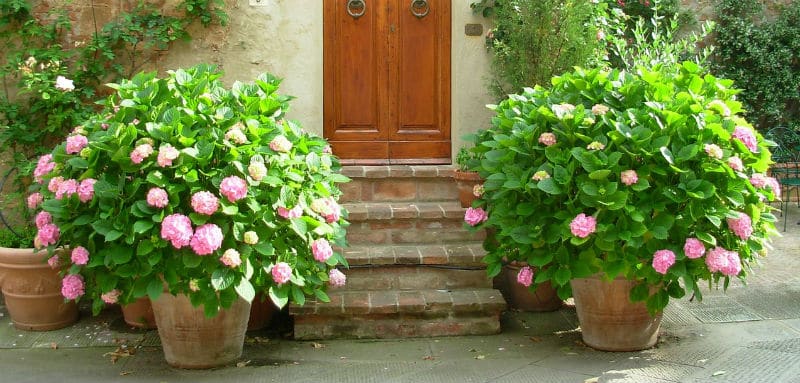
How to prune hydrangeas
Our site is reader supported, this means we may earn a small commission from Amazon and other affiliates when you buy through links on our site.
Hydrangeas need love and care like any other plant and part of that is proper pruning. The methods used and the frequency of said pruning is contingent upon the species and your overall goals.
How do you prune a hydrangea?
There are different methods one can employ to properly prune hydrangeas. As your plants are establishing themselves you should begin with the process of deadheading.
How to Deadhead hydrangeas
Deadheading removes dead blooms. If you live in a mild area they can be removed immediately after flowering but when pruning hydrangeas UK residents in colder areas should leave the dead blooms on the plant throughout the winter to provide some frost protection for the growth buds underneath.
With winter coming to an end and spring well on its way, you can remove the dead flower heads and cut back the stem of the hydrangeas to the first set of strong, healthy buds.
If you have a lacecap hydrangea it’s a much stronger plant and as such the flower heads should be cut back after flowering, down to the second pair of leaves below the first head. This will prevent new seeds from developing which is important given that new seeds will consume energy required for the rest of the plant.
Cutting back hydrangeas
If you have established hydrangeas particularly lacecaps or mopheads, you should cut them back focusing on one or two of the oldest stems from the base. This will encourage the plant to produce replacement growth significantly more floriferous.
If your plant is doing poorly you can remove it by cutting off all of the stems directly to the base, but be aware that doing so will remove any flowers from that particular summer and you won’t get new stems until the following year.
Pruning Climbing Hydrangeas
Most people prune hydrangeas at the end of winter or the start of spring but if you have a climbing Hydrangea it is recommended that you prune it in the summer after it has flowered.
If you have a climbing Hydrangea cut back the overly long shoots immediately after flowering. In most cases, flowers will accumulate at the top of your plant so you want to leave as much of that area unpruned as possible.
If your climbing Hydrangea is well-established it will tolerate hard pruning every spring but if you cut extensively it will reduce flowering over the subsequent one or two summers. You can reduce the size of your plant in a gradual fashion by staggering the more drastic pruning every 3 or 4 years.
Different species may require slightly adjusted pruning methods and schedules.
Species | How to prune |
Lacecaps | Deadheading as discussed |
Mopheads | Deadheading as discussed |
Serrata | Deadheading as discussed |
Aspera | Minimal pruning is required in the spring to remove overly long stems and dead stems. |
Quercifolia | Same as Aspera |
Paniculata | It is only essential to remove dead wood from this species in the spring. When you prune the hydrangea to a core framework of branches annually it will produce more flowers. Every Spring be sure to cut back the stems from last year all the way down to a pair of healthy buds. Cut the larger framework to no more than 60 cm or two feet in height. For larger flower panicles, prune to the lowest pair of healthy buds but maintain a low framework of branches no more than 25cm, or 10 in, in height. |
Arborescens | Same as Paniculata |
Read next: How to prune Lavatera plants
Other Techniques to prune your hydrangeas
In some cases you might want to do something other than regular pruning, pruning for a purpose.
To tidy up the appearance of your hydrangeas, you can remove old blooms simply snipping them off below the flower head. Concurrently you can remove any straggly canes that have fallen to the soil level.
If you want to improve the vigour of your hydrangeas, focus on removing the oldest canes. As hydrangeas get older they become woodier and produce smaller blooms. If you want to bring back the large, abundance flowers you can remove some of the oldest canes to keep your shrub vigorous.
When things have grown a little out of hand and you want to keep your shrub from getting too tall, use the same technique as you would improve the vigour of your plant but remove the tallest canes.
If you look at your hydrangea and it’s starting to flop over under the weight of its blooms, you can cut the stems so that they only reach between 18 and 24 in, giving it a sturdy or framework better supportive of new growth.
Should you wish to encourage blooms on new wood, cut back the shrubs at the end of winter before any new growth has an opportunity to grow.
In situations where you want to get bigger flowers, cut the older flowers back all the way at the end of winter or the very beginning of Spring. Smooth hydrangeas will give you larger blooms if you prune them like this every year.
Overall, pruning is a fairly simple, straightforward technique. Once you know what you want to achieve with your pruning, you will know when and how to employ your pruning techniques.